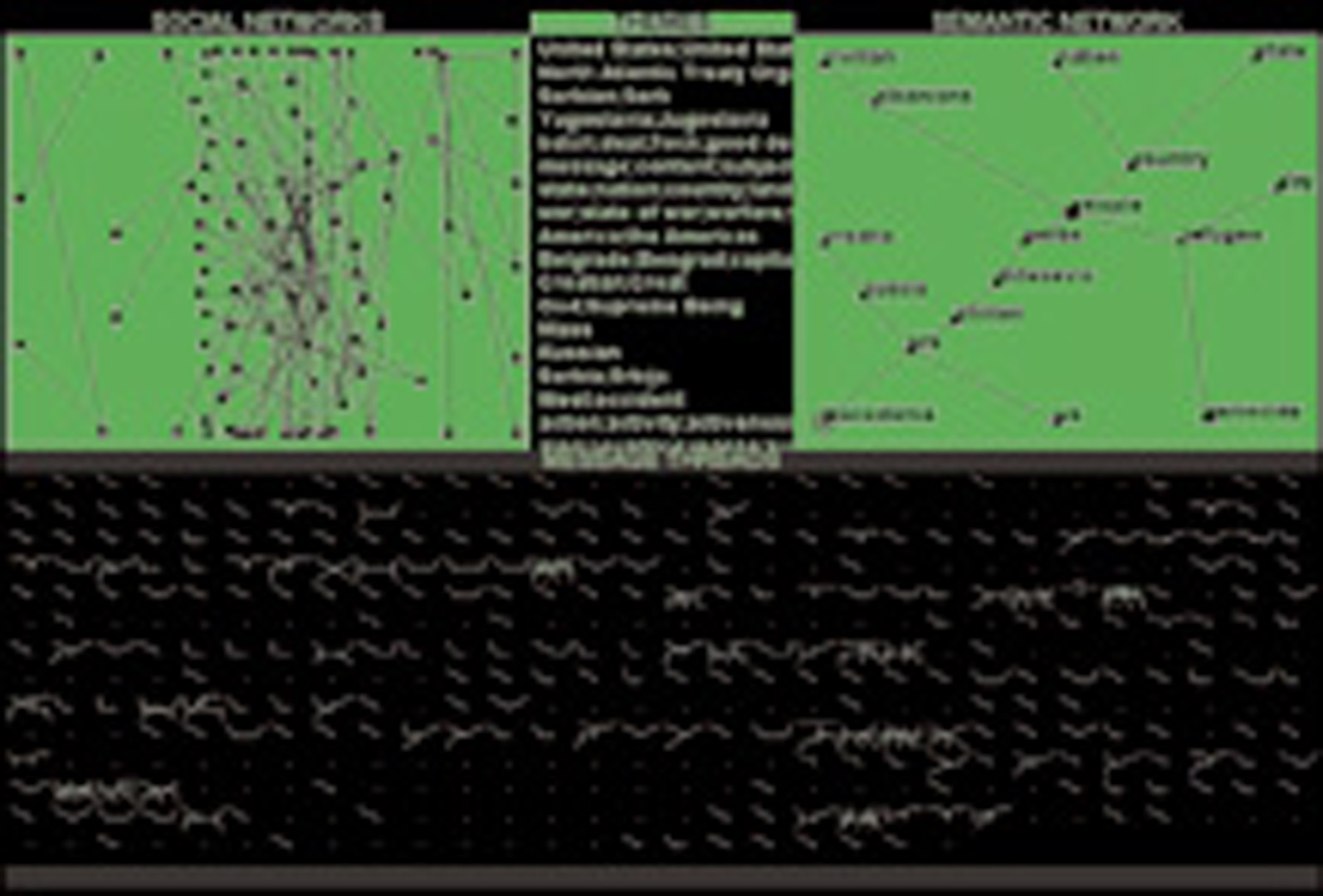“What Does a Very Large-Scale Conversation Look Like?” by Sack
Conference:
Type(s):
Title:
- What Does a Very Large-Scale Conversation Look Like?
Presenter(s)/Author(s):
Abstract:
Introduction
The new electronic spaces that I am interested in have the following characteristics in common:
• They are large. Many server sites now support interchanges between hundreds and thousands of people. Usenet newsgroups and large listservs are the most common such sites. I call these usually text-based, usually asynchronous interchanges very large-scale conversations.
• They are network-based. More specifically, they support network-based communities. The boundaries of these spaces and the communities they support are not geographic boundaries. Communities of artists, writers, and scientists are examples of pre-Internet, network-based communities (communities based upon a social network and some shared interests or needs). Network-based communities are of a different kind than geographically based communities like neighborhoods, cities, and nations. Network-based communities (for example, the scientific community) have continued to grow with the help of new network technologies, but contemporary technologies have also engendered a variety of new communities (for example, the open source community).
• They are public. As more and more people gain access to the Internet from their homes or schools rather than from their workplaces, the Internet increasingly becomes a space for public discussion and exchange. Very large-scale conversations are a common event within the confines of large industry (for example, the huge number of communications among thousands of people required to design and build an airplane or coordinate production of a film). However, these have a distinctly different character than the very large-scale conversations in which people are participating as individuals rather than as employees. The Internet is engendering the production of new public spaces that may offer the means to reinvigorate public discourse.
References:
References
1. Cannon, S. & Szeto, G. (1998). Parasite. URL: parasite.io360.com/index.html and www.cybergeography.org/atlas/topology.html
2. Card, S. K., Mackinlay, J. & Shneiderman, 8. (editors), Readings in information visualization: Using vision to think. San Francisco, CA: Morgan Kaufmann
Publishers, 1999.
3. Deleuze, G. (1998). Foucault. Trans. & ed.: Sean Hand (Minneapolis: University of Minnesota Press, 1988).
4. Donath, J. Karahalios, K. & Viegas, F. (1999). Visualizing conversations. In Proceedings of HICSS-32. Maui, HI: IEEE Computer Society, January 5-8, 1999.
5. Dourish, P. & Chalmers, M. (1994). Running out of space: Models of information navigation. Short paper presented at HCI’94.
6. Dumit, J. (2000). Artificial participation: An interview with Warren Sack. In Zeroing in on the tear 2000. Late editions 8, Cultural studies for the end of the century, edited by George E. Marcus. Chicago: University of Chicago Press, 2000.
7. Fellbaum, C. ed. WordNet: An Electronic Lexical Database. Cambridge, MA: MIT Press, 1998.
8. Foucault, M. Parrhesia and community life. In Discourse and truth: the problematization of parrhesia, six lectures given at the University of California at
Berkeley, October November /983, edited by Joseph Pearson. URL: www.parrhes,ast.com
9. Garfield E. (1979). Citation indexing: Its the01y and applications in science, technology and humanities. New York: John Wiley, 1979.
10. Grefensrette G. (1994). Explorations in automatic thesaurus discovery. Boston: Kluwer Academic Publishers, 1994.
11. Hague, 8. N. & Loader, 8. D. (1999). Digital democracy: discourse and decision making in the information age. New York: Routledge, 1999.
12. Hirst, G. & St-Onge, D. (1998). Lexical chains as representations of context for the detection and correction of malapropisms. In WordNet: An Electronic
Lexical Database, edited by Christiane Fellbaum. Cambridge, MA: MIT Press, 1998.
13. Hutchby, I. & Wooffitt, R. (1998). Conversation analysis: principles, practices, and applications. Malden, MA: Polity Press, 1998.
14. Lakoff, G. & Johnson, M. (1980). Metaphors we live by. Chicago: University of Chicago Press, 1980.
15. Lyotard, J. F. (1988). The differend: Phrases in dispute. Trans. Georges Van Den Abbeele. Minneapolis: University of Minnesota Press, 1988.
16. Munro, A. J., Hook, K., & Benyon, D. (Eds.). Social navigation of information space. New York: Springer Verlag, 1999.
17. Resnick, P. & Varian, H. R. (I 997). Introduction: Special section on recommender systems. Communications of the ACM, 40, (2).
18. Richard, F. (2001). Utterance is place enough: Mapping conversation. Cabinet: A quarterly magazine of art and culture, 2, Spring 200 I.
19. Sack, W. (1998). Artificial intelligence and aesthetics. In The encyclopedia of aesthetics, volume 1, Michael Kelly, editor-in-chief. New York: Oxford University Press, 1998.
20. Sack, W. (1999). Stories and social networks. In the Proceedings of the American Association of Artificial intelligence workshop on narrative intelligence, edited by Phoebe Sengers and Michael Mateas. Cape Cod, MA: AAA], November 1999.
21. Sack, W. (2000). Discourse diagrams: Interface design for very large-scale conversations. In the Proceedings of the Hawaii International Conference on System
Sciences, Persiste11t Conversations Track. Maui, HI: IEEE Computer Society, January 2000.
22. Sack, W. (2000). Conversation map: A content-based Usenet newsgroup browser. In Proceedings of the International Conference on Intelligent User fnterfaceJ.
New Orleans, LA: Association for Computing Machinery, January 2000.
23. Sack, W. & Dumit, J. (1999). Very large-scale conversations and illness-based social movements. Presented at Media in Transition. Cambridge, MA: MIT,
October, 1999.
24. Schiffrin, D. (1994). Approaches to discourse. Cambridge, MA: Blackwell, 1994.
25. Kurgan, L. (2000). Spot 083-264: Kosovo, June 3, 1999. In World Views: Maps & Art curated by Robert Silberman. Minneapolis: University of Minnesota Press, 2000.
26. Tsagarousianou, R., Tambini, D., & Bryan, C. (Eds.). Cyberdemocracy: Technology, cities, and civic networkJ. New York: Routledge, 1998.
27. UNDP. New technologies and the global race for knowledge. In The Human Development Report. UN Development Programme, 1999.





